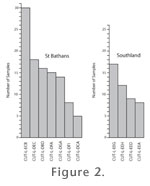|
||||
RESULTSTwenty-five species of Lauraceae have been recognized in this study. For three of these species the leaf morphology is known, but the rest are known only as fragments of dispersed cuticle. Most species are very distinct, but several of them have a generalised morphology, which may include subtly different species, therefore this number is likely to be a minimum. Based on the criteria in Christophel and Rowett (1996) four genera of Lauraceae were identified; Beilschmedia (with buttressed epidermal cells), Cryptocarya (stomatal complexes with broad, prominent scales), Endiandra (with two distinct, semi parallel scales in the stomatal complexes), and Litsea (with papillate epidermal cells). Ninety percent of all St Bathans samples had some Lauraceae cuticle, and those without Lauraceae tended to be low diversity samples dominated by the conifer Retrophyllum and the Myrtaceae taxon CUT-M-DID (probably a Syzygium, Pole unpublished). Although not quantified, Lauraceae cuticle, fragments of leaves, or intact leaves, were clearly dominant in most samples. Twenty-two Lauraceae taxa are present in the Paleovalley, with the highest number of Lauraceae in a single sample being 10 (BL-32). Among samples in which the family is present, the average number of Lauraceae taxa is three. Research in progress suggests that, with rare exceptions, the St Bathans Paleovalley assemblages probably come from a single broad community. That is, the 22 species would have been found growing contemporaneously over an area of a few square kilometers of the valley floor. As present-day communities with Lauraceae near their cold limits only have one or two species of the family, the diversity of Lauraceae in the St Bathans Paleovalley clearly indicates temperatures were well above the minimum limit for the family.
Nine species (36%) are found in both the St Bathans Paleovalley and Southland, but only one of these (CUT-L-DFI) is among the most widespread taxa in either basin (Figure 2). That is, both areas had a distinctly different suite of dominant Lauraceae. This may be due to the major edaphic differences between the basins—the gravel dominated St Bathans Paleovalley, and the peat and clay-rich delta of the Southland coal measures. It is possible that what are perceived to be widespread, generalist species at the local level, may in fact be edaphic specialists, widespread only in the specific environments which typify each basin. |
||||
